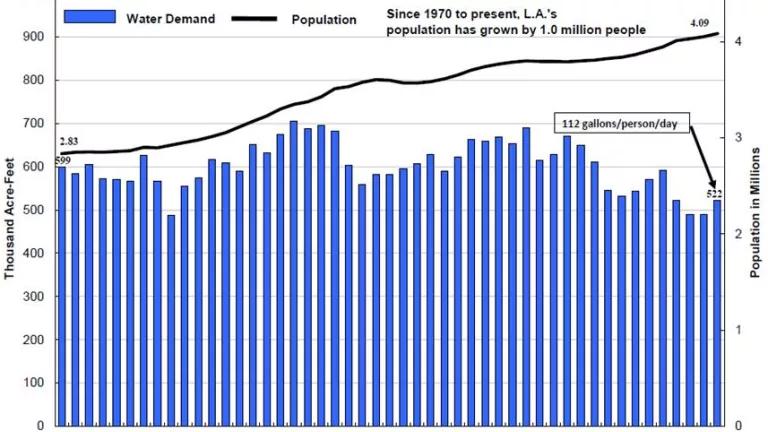Keeping Water Demand in Check
A new tool is shedding light on a growing mismatch between the supply and demand of fresh water.

A new tool from the World Resources Institute for assessing water stress around the globe is shedding much-needed light on a growing mismatch between the supply and demand for fresh water. But an article surveying the data assembled by WRI for the digital New York Times this week missed the mark in describing California’s situation, where water use tops all other states.
Following a paragraph on the recent crisis in Cape Town, where residents are competing with farmers for limited water resources, the article stated,
Likewise, Los Angeles. Its most recent drought ended this year. But its water supply isn’t keeping pace with its galloping demand and its penchant for private backyard swimming pools doesn’t help.
We should be cautious about assertions of "galloping demand" for water in the US in general, and in Los Angeles in particular. In the city of Los Angeles, per capita water use has actually dropped—dramatically so—to the extent that in 2018, total water use in LA was lower than it was in 1970, despite over one million more city residents, as shown by this graphic from the Los Angeles Department of Water and Power.
At the Federal, state, and local level, the US has put into place policies and practices that have led to a decline in per capita and per household water use across the country over the last 15 to 20 years. I’ve previously written about the trends in declining US urban water use set in motion by the enactment of water efficiency standards in 1992. The latest water use tabulation from the US Geological Survey shows this trend clearly as well. Water consumption in the US is still relatively high by comparison with other countries, but the trajectory is clearly downward.
NRDC and allies are pursuing policies that will further reduce unnecessary water use in the years ahead, a strategy made even more compelling as the impacts of climate change on our water supplies become increasingly evident. These policies include stronger building and plumbing codes, standards for more efficient water-using products, and sensible pricing that encourages efficient use while keeping essential water needs affordable for all households. And additional retirements of aging coal-fired power plants with once-through cooling systems -- an essential step in any meaningful strategy to combat climate change—will provide further large reductions in fresh water withdrawals.
In California, the state has acted to curb excessive urban water use in many ways. This week, the state is scheduled to adopt a new regulation for lawn sprinklers that will reduce their water use by about 20% and is estimated to save more water each year than all the water used in San Diego, the state's second largest city. (California will actually be the fifth state to adopt these standards for lawn sprinklers.) Other regulations sharply limit the amount of traditional turf grass and other water-thirsty landscape plantings that can be installed in new construction. Although implementation is spotty, California’s landscape designers and contractors have become well adept at installing attractive landscapes that require little supplemental water. Additionally, the state has begun work on new regulations that will set specific targets for each urban water supply system to reduce leakage from water mains and service pipes—a first-in-the-nation requirement. Another first will be community-by-community water efficiency targets being developed over the next several years in response to legislation recent legislation. My colleague Tracy Quinn, who helped shape this program, explains here.
The benefits of using water more efficiently extend beyond the relief provided to rivers, estuaries, fish, and wildlife. Saving water can lower bills for customers, including the low-income families hit hardest by rising utility costs. And by tempering our demand for water, our water and wastewater systems can direct their financial and managerial resources toward the long-neglected repair and replacement of existing infrastructure, rather than to costly investments in system expansion.
There is much more work to be done—with agricultural water efficiency among the biggest challenges. But new technologies, sensible water pricing, and growing public awareness can make further gains possible—if we adopt policies that encourage these outcomes. Building on these successes, the products and services now being applied in the US can help address the global water stresses identified in the Times piece.




